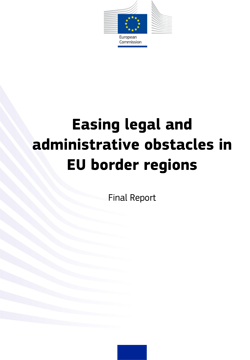
Studies
Date: 13 sep 2017
Theme: Cooperation between regions and countries, Business support, Transport, Social inclusion, Jobs, Education and Training
Languages: en
The study was launched in 2015 as one of the pillars of the cross-border review. It analyses three general categories of border obstacles emerging from local, regional national or EU legislation as well as from different administrative practices:
- Legal obstacles caused by an absence of EU legislation in policy fields;
- Legal obstacles caused by incoherent or inconsistent domestic laws of EU-Member States in policy fields where no or only a partial EU competence does exist;
- Administrative obstacles caused by inadequate procedural and adverse behavioural aspects at the local, regional or national levels.
The study includes a final report and 15 case studies.
The inventory is an empirical “snapshot” of a specific situation prevailing in border regions in the period 2011-2015. It includes over 200 cases of legal and administrative obstacles based on an extensive literature review and online research. Due to limited information, it covers 37 out of the 40 land border regions. However, the number of obstacles identified for each of these 37 internal Union land borders is highly variable. The inventory shows that a multitude of legal and administrative obstacles exists on all borders and in the timeframe covered by this study. They all have an adverse effect on the life of border citizens or deter them from fully harnessing the potential of their place of residence or work. The obstacles described in the inventory differ in their nature, their causes and impact on the border regions.
Furthermore, 15 case studies were carried out, covering the five policy areas most affected (Labour Market & Education, Social Security & Health, Transport & Mobility, Industry & Trade and Policy Planning and provision of Public Services). Each case study focuses on a specific obstacle or exceptionally on a group of closely related obstacles. Their main objective was to elaborate a tool that could provide interesting points of reference and/or lessons for a wider policy and practice audience beyond the illustrative spatial examples used to illustrate each case study. The research involved consultations with the Commission, regional and local stakeholders.
Annexes
- Healthcare - Obstacles arising from different national systems (Finland-Sweden) en
- Labour mobility - Obstacles for cross-border commuters (Denmark-Sweden) en
- Labour mobility - Recognition of professional qualifications and educational diplomas (Spain-Portugal) en
- Business - Trade-related obstacles faced by businesses along the border (Ireland-United Kingdom) en
- Rail transport - Technical interoperability and investment coordination between national railway systems (Austria-Slovenia) en
- Emergency response - Obstacles linked different national management systems handling crises and disasters (Slovakia-Hungary) en
- Transport infrastructure - Policy frameworks hampering development of regional transport infrastructure (Germany-Poland) en
- Police cooperation - Complexity of structures and rules on the border (Germany-Poland) en
- Labour mobility - Obstacles in the recognition of professional qualifications (Belgium-Germany-France-Luxembourg) en
- Social security - Difficult access to social security for frontier workers (Belgium-Germany-France-Luxembourg) en
- Education - Language requirements preventing VET students from studying abroad (Germany-The Netherlands) en
- Spatial planning - Obstacles to cross-border public consultations (Belgium-France) en
- Urban transport - Non-harmonised ticket pricing systems (Germany-France) en
- Business - Complex rules hampering cross-border activities (Bulgaria-Greece) en
- Healthcare - Obstacles to the efficiency and effectiveness of health systems (Estonia-Latvia) en
- Inventory of border obstacles en
